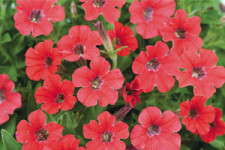Tips For Producing Petunias

Vigorous vegetatively produced petunias have revolutionized the genus and come in all sizes and colors. How do you ensure you’re growing the highly branched, compact, vegetative petunias the market loves? With a carefully planned and targeted program that accounts for their extreme vigor and heavy feeding needs. Danziger, which is known for its Cascadia, Doubloon, Littletunia and Ray series, shares production advice:
Rooting
Root for two to three weeks at temperatures of 64-75°F.
Planting
For 4-inch pots, use one plant per pot. Plants will be ready for sale from rooted cuttings within six to eight weeks.
For 6-inch pots, use one to two plants per pot. Plants will be ready in eight to 10 weeks.
For 10-inch hanging baskets, use three to four plants, which will be ready in 10 to 12 weeks.
Pinching
Pinch once two weeks after planting. A second pinch is recommended for baskets. Plants may also be cut instead of pinched.
Growing On
After transplant, during the first two to three weeks, water and fertilize moderately and keep EC between 1.5 and 1.8. Let roots reach the side of the container before increasing water and fertilization.
Lighting
Plants prefer high light intensities, preferably full sunlight, which is essential for optimum finish. Minimum light levels are 6,000 foot candles or 60,000 lux. If shaded, plants will appear stretched and less blooming. During winter, supplemental lighting is required.
Temperature
Provide day temperatures of 64-75°F and night temperatures of 55-64°F. Plants can grow in temperatures out of this range, nearly to the freezing point and up to 95°F.
Fertilization
Vegetative petunias require heavy fertilization. Apply a constant feed program with a balanced fertilizer of N:P:K=2:1:2, using 250-300 ppm nitrogen.
Micronutrients should be in average levels with iron slightly higher.
Irrigation
Keep plants well watered, though keep in mind vegetative petunias are sensitive to water surplus. Drip irrigation is recommended. Leach periodically to prevent salt accumulation.
Growing Media
Use a well-drained peat/perlite, disease-free potting mix with a pH of 5.5-6.0 and EC of 0.8-1.2.
Growth Regulators
Growth regulators are optional for vegetative petunias. They aren’t necessary under high light intensities. If you apply them, use one to three sprays of B-Nine, 2 grams per liter, according to required plant size. Bonzi is an effective regulator for 4-inch pot production.
Pest & Disease Control
Apply a standard preventive spray program to control pests and diseases. Potential insect problems include whiteflies, leaf miners and aphids. Watch for diseases, including Botrytis, Pythium and crown rot. Viral diseases can be a serious problem, therefore, it’s essential to start with virus-free material. Plant liners at the soil level, not too deeply. Avoid excessive moisture on foliage.










